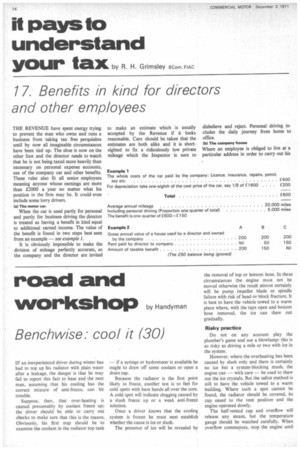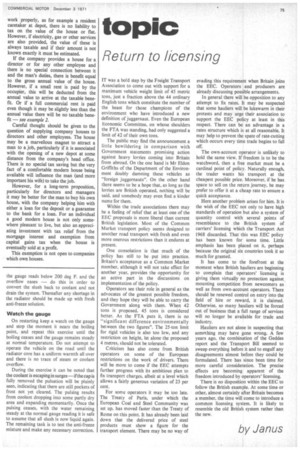road and workshop
Page 76

Page 77

If you've noticed an error in this article please click here to report it so we can fix it.
Benchwise.cool it (30) IF an inexperienced driver during winter has had to top up his radiator with plain water after a leakage, the danger is that he may fail to report this fact to base and the next man, assuming that his cooling has the correct mixture of anti-freeze. can hit trouble.
Suppose, then, that over-heating is caused presumably by coolant freeze up; the driver should be able to carry out checks to make sure that this is the reason. Obviously, his first step should be to examine the coolant in the radiator top tank — if a syringe or hydrometer is available he ought to draw off some coolant or open a drain tap.
Because the radiator is the first point likely to freeze, another test is to feel for cold spots with bare hands all over the core. A cold spot will indicate clogging caused by a slush freeze up or a weak anti-freeze solution.
Once a driver knows that the cooling system is frozen he must next establish whether the cause is ice or slush.
The presence of ice will be revealed by
the removal of top or bottom hose. In these circumstances the engine must not be moved otherwise the result almost certainly will be pump impeller blade or spindle failure with risk of head or block fracture. It is best to have the vehicle towed to a warm place where, with the taps open and bottom hose removed, the ice can thaw out gradually.
Risky practice
Do not on any account play the plumber's game and use a blowlamp: this is as risky as driving a mile or two with ice in the system.
However, where the overheating has been caused by slush only and there is certainly no ice but a system-blocking mush. the engine can — with care — be used to thaw Out the ice crystals. But the safest method is still to have the vehicle towed to a warm building. Where such a spot cannot be found, the radiator should be covered, its cap eased to the vent position and the engine operated slowly.
The half-vented cap and overflow will release any steam, but the temperature gauge should be watched carefully. When overflow commences, stop the engine until the gauge reads below 200 deg F. and the overflow eases — do this in order to convert the slush back to coolant and not drain the system. Thereafter any shortage in the radiator should be made up with fresh anti-freeze solution.
Watch the gauge On restarting keep a watch on the gauge and stop the moment it nears the boiling point, and repeat this exercise until the boiling ceases and the gauge remains steady at normal temperature. Do not attempt to operate the vehicle on the road until the radiator core has a uniform warmth all over and there is no trace of steam or coolant overflow.
During the exercise it can be noted that the coolant is escaping in surges — if the cap is fully removed the pulsation will be plainly seen, indicating that there arc still pockets of frost not yet cleared. The pulsing results from coolant dropping into some partly dry area and expanding momentarily. Once the pulsing ceases. with the water remaining steady at the normal gauge reading it is safe to assume that all slush is now liquid again. The remaining task is to test the anti-freeze mixture and make any necessary correction.


































































































































